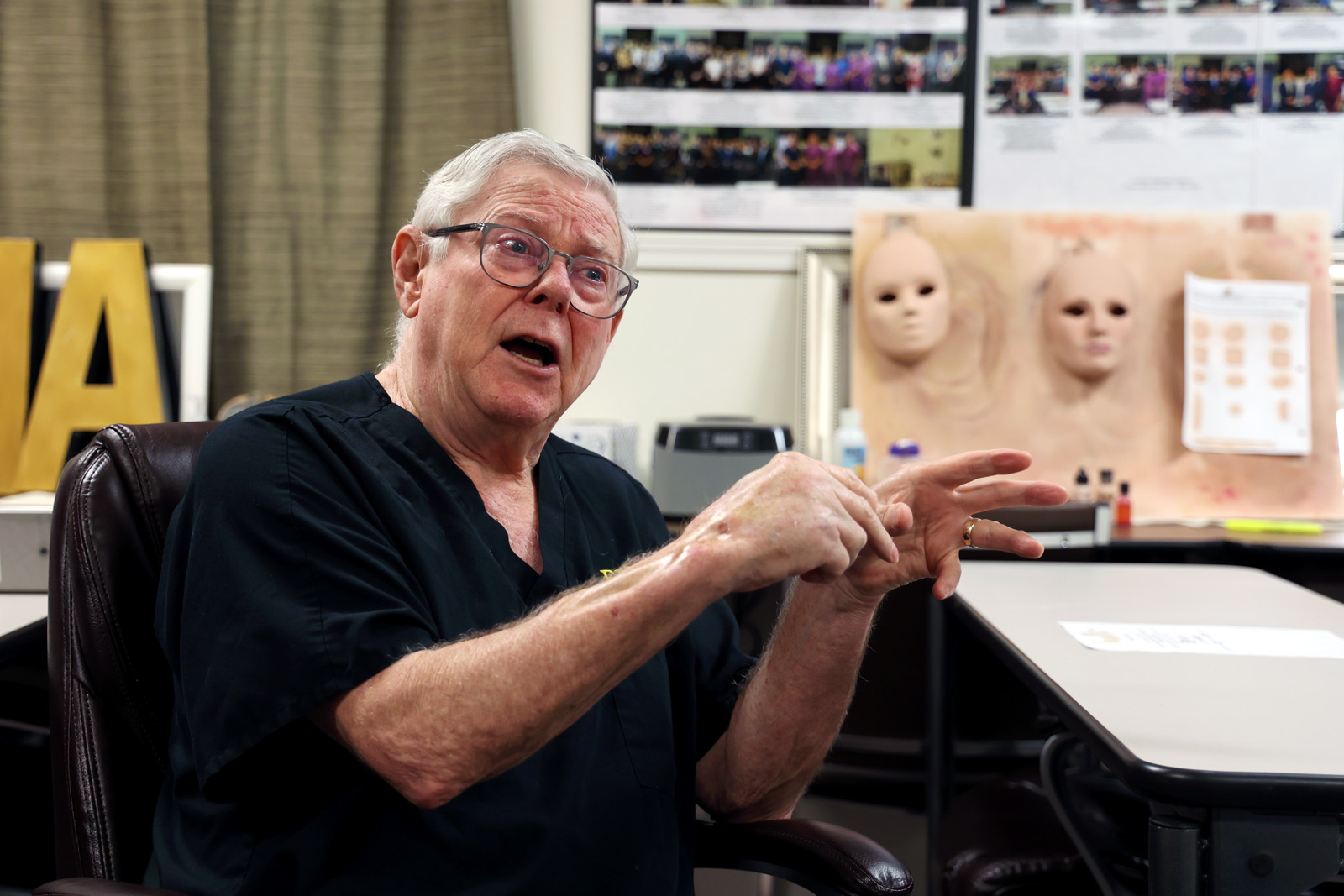Editor's note: An earlier version of this story inadvertently used a photo that was published without proper permission of the photographer.
OPINION |
The well-known boat that was built — but never finished — by World War II veteran Robert Rosendahl has been moved from its storage place in Republic, and also apparently put up for sale by someone who did not own it.
Rosendahl died at 98 on Feb. 2, 2020 — 40 days after the love of his life, Bettie Hefti, passed away.
The last time I saw the steel-hulled, 8,000-pound boat was November 2020, when a tow truck — bigger and stronger than the first one that tried and failed that day — took it from the side yard of Rosendahl's house at Golden Avenue and Republic Road.
The boat had sat there in the brush for some 50 years.

Built for the sea, but never been on water

It was towed to a storage facility in Republic, where a group of men in their 60s, including Rosendahl's son Erik, vowed to finish the job of making the boat seaworthy and then sailing the craft to Tahiti. They would do it in Robert Rosendahl's honor.
At one point in his life, sailing a boat to Tahiti was Rosendahl's plan.
But that changed. He stopped working on the boat in about 2000.
When local businessman Doug Pitt in 2015 offered to help fund completion and restoration, Rosendahl said thanks, but no thanks. He had moved on.
Pitt told me back then that he often wondered about the boat since his days at Kickapoo High School.
Today, the boat, which has never been on water, sits far from the South Pacific on a farm near Halltown, just west of Greene County, says Kirk Murrell, 66, a friend of Erik Rosendahl's.
“I do not know that I will live to see it sail on the ocean,” Murrell tells me.
Instead, he hopes to witness it navigate either Table Rock or Stockton lakes.
Man calls to say he saw boat listed for sale
In an odd, troubling twist, a man named Benjamin Bloomer called me weeks ago to say he saw an online ad for the boat; someone was trying to sell it.
Bloomer, 42, says he went to look at the boat when it was still stored in Republic.
“After I got there I found out it was solid steel, which really surprised me,” he says. “I thought it might be a neat restoration project if it was cheap enough.”
The seller also had a copy of the boat's history, which stated it was built by Robert Rosendahl, Bloomer says.
It did not take Bloomer long to discover the history behind the builder's name and to conclude the woman probably never owned the boat.
She eventually told him it had been moved from the Republic storage site in June and was no longer for sale.
Murrell says he never saw the ad but assures me ownership never changed hands and he suspects someone was trying to pull a con.
I have the name of the woman who apparently tried to sell the boat. I have reached out to her via phone and Facebook. I have not heard back.
The boat was moved in June. Here's why:
In November of 2020, when the boat was moved from the house, the owner of the storage place knew the history and offered a discounted monthly fee. It was stored outdoors.
But ownership of the storage business changed and, first off, the new owner could not find the word “boat” in the storage contract because it wasn't there, Murrell says.
Second, the new owner did not want anyone working on it while it was in storage.
So, it had to be moved. Unfortunately, Murrell says, as we learned earlier it takes time to find someone to move a four-ton boat.
At one point, Murrell says, the new owner of the storage business relayed the message that if the boat wasn't moved by Murrell and his friends that he would move it himself to a destination of his choosing.
He built the boat in his mind to survive
Rosendahl survived the hell of 3.5 years of confinement in a World War II prisoner-of-war camp by imagining the boat he would build if he survived the horrors of war.
He was born in Minnesota, the Land of 10,000 Lakes, and when he went off to fight he carried with him real instructions on how to build a boat.
Someday, God willing, he would be a free man, he told himself, and he would sail the boat he would build and feel the sea breeze in his face.

Rosendahl, a long-time Springfield resident, was one of many American and Filipino soldiers who fought valiantly in the Philippines for three months without adequate support. They ran out of artillery shells and surrendered to the Japanese.
Many of the same Japanese soldiers he had been fighting — who had seen their comrades fall in battle at the hands of the Americans — were given the task of leading Rosendahl and the other prisoners on the Bataan Death March.
It was 60 miles, the distance from Springfield to Carthage.
“On the second day there was no water and no food,” Rosendahl once told me.
I was fortunate to know Bettie and Bob late in their lives and wrote about them and the boat.
Story continues below
He saw men killed by bayonet
Rosendahl witnessed prisoners killed by bayonet because they could no longer keep up in the march. He saw other prisoners become hysterical due to lack of water. They were shot and killed.
He survived what no human should ever have to survive: war, hand-to-hand combat, slave labor, starvation and torture.
Yet, he endured, and through a grace that borders on divine, he lived a bountiful life. He and Bettie were married 73 years and had six children.
Bettie put out sign: “Repent ye sinners!”
Maybe you remember seeing the boat. For a few, I'm sure, it was an eyesore, but only for those who did not know the story.
For a while, Bettie had set a sign by it in response to those comparing it to Noah's Ark.
It said: “Repent ye sinners!”
Rosendahl stopped working on it in 2000.
After he and Bettie died, the house was up for sale and the boat had to be moved.
The boat is a 38-foot beast, built for the seven seas.
Just about everything in it was made by Rosendahl. Whatever he touched was made far beyond minimum specs.
The hull, for example, is thicker and stronger than the specs. The engine, built by Rosendahl is 65 horsepower, instead of 35.
Rosendahl made the boat to survive just about anything — the same way God had made him.
If you want to help, you can
Murrell says he and Erik Rosendahl have done “little things” to repair it.
“Once I got the electrical wiring mapped out, I played some electricity into it and everything worked just fine,” Murrell says.
One setback, he says, is that his pickup was stolen. Insurance covered the loss of the truck but not $5,000 in tools and another $3,000 or so parts he had purchased for the boat.
Murrell says you can call him direct at 417-893-9192 if you can help with the work or with a monetary donation. You can donate through GoFundMe.
“The family would just love to see it in the water and floating and under its own power,” he says.
This is Pokin Around column No. 55.



